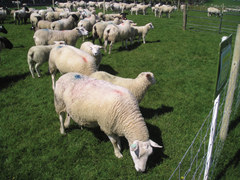Agriculture update
 Richard Halleron reviews the year so far for the farming and food sectors. Input costs remain high but farmers benefit from the end of cheap food.
Richard Halleron reviews the year so far for the farming and food sectors. Input costs remain high but farmers benefit from the end of cheap food.
It’s time for a half term report on the state of agriculture in 2011. Talk to any local farmer about the state of his business at the present time and, invariably, he will give the following response: “I am happy enough with prices but input costs are far too high.”
The reality is that fertiliser, feed and fuel costs look set to strengthen in the medium and long term. These are the three main inputs, which farmers must buy to secure the future of their businesses.
All of the top economists keep telling us that farming and food now have the potential to lift Northern Ireland as a whole out of recession. Currently, both sectors combined add around £3 billion into the local economy and account for around 50,000 jobs. Agriculture, for its part, works at all levels of the economy. Farmers spend millions every year with local suppliers. But they can’t spend money they don’t have. So if farming is to play the crucial role we all want it to have, then producers must receive realistic prices for their beef, milk, lamb, pork etc. Or put another way: the days of cheap food are over.
But the good news is that farmgate prices are now moving in the right direction. Beef, dairy, lamb, pork and cereal returns are all strengthening. The United Dairy Farmers’ milk auction, held at the end of June, saw prices rise by 1.4 pence per litre to reach almost 28 pence. This is an unprecedented price, paid at a time of the year when cows receive the bulk of their diet from grazed grass, the cheapest feed source that is available to Irish farmers.
Agriculture is one of those few economic areas where the ministerial incumbent at Stormont can make a real difference. The new girl on the block is Sinn Féin MLA Michelle O’Neill. And despite being in the job for only a few short weeks, she is already starting to make a real difference.
The South Tyrone MLA has confirmed publicly that she wants the new Executive to fully recognise the potential of the agri- food sectors to lead the entire economy out of recession.
And to this end she has already written to Enterprise Minister Arlene Foster, asking for DARD to be included as part of the Executive sub-committee charged with the responsibility of developing a recovery strategy for the local economy.
Michelle O’Neill is fully aware of the agri- food sector’s potential to deliver more wealth creating opportunities and jobs over the coming years. Her role will be to ensure that everything possible is done to convert all of this potential into reality.
But there are many challenges ahead for the new Farm Minister, by far the biggest being her input into the forthcoming review of the Common Agricultural Policy (CAP).
In this context, her sole objective must be to get the maximum level of support possible from Brussels for local agriculture. And to that end, one must assume that our new Farm Minister will be starting with the point of view that the current level of support is not adequate.
Crucially, she is already on record as saying that Northern Ireland must be allowed to have its own separate and distinct voice in Brussels, both in the run up to and during the actual review negotiations. This will be a tremendously important step forward, if it can be achieved.
Michelle O’Neill is already conscious of theß excessive levels of red tape which local farmers have to deal with on an almost daily basis. Many of these bureaucratic hurdles can be traced back to the overly complicated regulations emanating from the last CAP review process. So let’s hope that she can also do her bit to ensure that we end up with a much more simplified CAP post the forthcoming review discussions.
Michelle O’Neill has inherited a number of policy commitments from her predecessor Michelle Gildernew, which come under the category of ‘work in progress’. These include the implementation of a rural action plan and the resolution of the DARD budget.
On the specifics of DARD’s future budgetary allocation, the new Farm Minister confirmed that essential services to farmers will be protected. But what really constitutes an essential service in this regard? We will soon find out.
Meanwhile, back on the land, farmers continue to battle with the day-to-day vagaries of the Irish weather. No other industrial sector is so dependent on the elements for its very survival. April brought with it a month of almost wall-to- wall sunshine. Since then, however, things have gone downhill badly. May and June have been two of the coldest spring and summer months on record. So, irrespective of whatever the markets are doing, local farmers will be praying for a decent back end, which will allow them get out into the fields with the sun on their backs.







